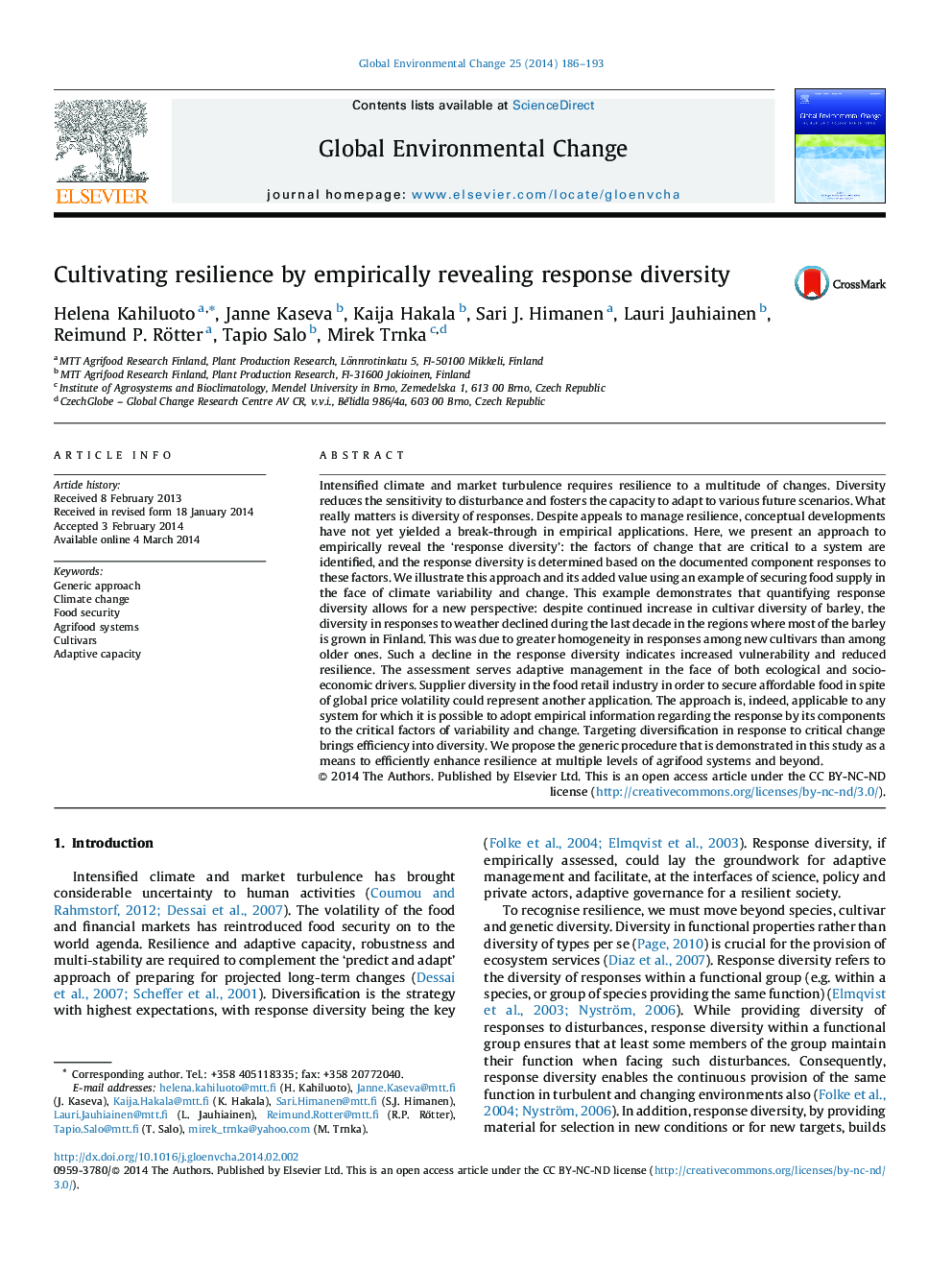| کد مقاله | کد نشریه | سال انتشار | مقاله انگلیسی | نسخه تمام متن |
|---|---|---|---|---|
| 7470596 | 1485133 | 2014 | 8 صفحه PDF | دانلود رایگان |
عنوان انگلیسی مقاله ISI
Cultivating resilience by empirically revealing response diversity
ترجمه فارسی عنوان
انعطاف پذیری را به صورت تجربی نشان می دهد
دانلود مقاله + سفارش ترجمه
دانلود مقاله ISI انگلیسی
رایگان برای ایرانیان
کلمات کلیدی
رویکرد عمومی، تغییر آب و هوا، امنیت غذایی، سیستم های کشاورزی ارقام ظرفیت سازگاری،
ترجمه چکیده
آب و هوای شدید و آشفتگی بازار، مستلزم انعطاف پذیری در برابر بسیاری از تغییرات است. تنوع حساسیت به اختلال را کاهش می دهد و ظرفیت انطباق با سناریوهای آینده را افزایش می دهد. آنچه واقعا مهم است تنوع پاسخ ها است. با وجود تجدیدنظر برای مدیریت انعطاف پذیری، تحولات مفهومی هنوز در برنامه های تجربی ناکافی بوده است. در اینجا، روشی را برای تجربی "تنوع پاسخ" نشان می دهیم: عوامل تغییری که برای یک سیستم حیاتی هستند شناسایی می شوند و تنوع پاسخ بر مبنای واکنش های جزئی مستقل از این عوامل تعیین می شود. ما این رویکرد و ارزش افزوده آن را با استفاده از نمونه ای از تأمین مواد غذایی در مواجهه با تغییرات و تغییرات اقلیمی نشان می دهیم. این مثال نشان می دهد که تنوع پاسخ دهی به اندازه کافی برای یک دیدگاه جدید امکان پذیر است: با وجود افزایش ادامه تنوع جو در جو، تنوع در پاسخ به هوا در دهه اخیر در مناطقی که اغلب جو در فنلاند رشد می کند، کاهش یافته است. این به دلیل همگن بودن بیشتر در پاسخ های بین ارقام جدید نسبت به افراد مسن تر بود. چنین کاهش در تنوع پاسخ، افزایش آسیب پذیری و کاهش قابلیت انعطاف پذیری را نشان می دهد. ارزیابی مدیریت سازگار با موانع زیست محیطی و اجتماعی و اقتصادی را ارائه می دهد. تنوع عرضه کنندگان در صنایع خرده فروشی مواد غذایی به منظور تامین غذای مقرون به صرفه به رغم نوسانات قیمت جهانی می تواند یک برنامه دیگر باشد. این رویکرد در واقع برای هر سیستم قابل استفاده است که ممکن است اطلاعات تجربی مربوط به پاسخ توسط اجزای آن را به عوامل بحرانی تغییرپذیری و تغییرات برساند. هدف قرار دادن تنوع در پاسخ به تغییرات بحرانی، بهره وری را به تنوع می بخشد. ما روش عمومی را پیشنهاد می کنیم که در این مطالعه نشان داده شده است به عنوان وسیله ای برای ارتقای قابلیت انعطاف پذیری در سطوح مختلف سیستم های کشاورزی و فراتر از آن.
موضوعات مرتبط
علوم زیستی و بیوفناوری
علوم محیط زیست
علوم زیست محیطی (عمومی)
چکیده انگلیسی
Intensified climate and market turbulence requires resilience to a multitude of changes. Diversity reduces the sensitivity to disturbance and fosters the capacity to adapt to various future scenarios. What really matters is diversity of responses. Despite appeals to manage resilience, conceptual developments have not yet yielded a break-through in empirical applications. Here, we present an approach to empirically reveal the 'response diversity': the factors of change that are critical to a system are identified, and the response diversity is determined based on the documented component responses to these factors. We illustrate this approach and its added value using an example of securing food supply in the face of climate variability and change. This example demonstrates that quantifying response diversity allows for a new perspective: despite continued increase in cultivar diversity of barley, the diversity in responses to weather declined during the last decade in the regions where most of the barley is grown in Finland. This was due to greater homogeneity in responses among new cultivars than among older ones. Such a decline in the response diversity indicates increased vulnerability and reduced resilience. The assessment serves adaptive management in the face of both ecological and socio-economic drivers. Supplier diversity in the food retail industry in order to secure affordable food in spite of global price volatility could represent another application. The approach is, indeed, applicable to any system for which it is possible to adopt empirical information regarding the response by its components to the critical factors of variability and change. Targeting diversification in response to critical change brings efficiency into diversity. We propose the generic procedure that is demonstrated in this study as a means to efficiently enhance resilience at multiple levels of agrifood systems and beyond.
ناشر
Database: Elsevier - ScienceDirect (ساینس دایرکت)
Journal: Global Environmental Change - Volume 25, March 2014, Pages 186-193
Journal: Global Environmental Change - Volume 25, March 2014, Pages 186-193
نویسندگان
Helena Kahiluoto, Janne Kaseva, Kaija Hakala, Sari J. Himanen, Lauri Jauhiainen, Reimund P. Rötter, Tapio Salo, Mirek Trnka,
